Gen Z, the cohort just entering the workforce, is stealing the headlines. Numerous studies have come out over the last year describing this generation, what they want, what they need, and what they say. Often, the conclusions instruct HR and managers how to cater to these new workers (who are officially defined as born between 1997 and 2012.)
By focusing on how to redesign the workplace for Gen Z, we may be missing the big picture, one that has come into stark relief with the pandemic. Work from home and greater control over work/life balance has made us realize that workers differ in their preferences. Defining by generation, while sometimes informative, isn’t discrete enough.
Perhaps we should be asking: How do we create a workplace that allows for a variety of employee working preferences, regardless of generation, in a way that ensures that high quality work gets done?
Generation or Life Stage?
Many studies describe Gen Z as digital natives, growing up communicating through a small screen, skimming across multiple platforms. Consequently, the recommendation is to coach these new workers on interpersonal skills necessary in the workplace. For example, how to behave in meetings, one-on-ones, and interviews, as well as how to present to a broader audience.
But how different is this from any other generation just entering the workforce? Which raises the question, what is generational and what is life stage?
Compare employees in their 50s and older to those who are young and single. Similarities? Independence and flexibility. Empty-nesters are not as tied down as when they had families and were mid-career. Younger employees also often have fewer responsibilities and are more flexible in where they work and what kind of work they do.
Meanwhile, employees in any generation can be caregivers, needing flexibility to take care of a child, parent, or any person in their life with health difficulties. It’s not necessarily about generation or age but more about life circumstances.
Hybrid work — and the current debate over returning to the office or working from home — is at its heart of people wanting to be seen for who they are and getting what they need to be productive. What workers are really saying is, “See me for who I am individually. See me for me, help me do my best, given all the things that are happening in my life right now.”
Willing to Speak Up
One variable that often has the greatest impact on generations is what the workplace was like when the person first entered it. For example, Gen Xers came out of school into a recession and started their careers in the ‘90s when layoffs were ubiquitous. It was common to feel fortunate just to have a job. You didn’t complain.
Millennials and Gen Z are in a very different labor market. Perhaps that, along with their technological experiences on social media, makes them more comfortable speaking up. They’re not content with having their voices squashed. And that’s good for everyone.
Baby Boomers and Gen X wanted the same things earlier in their careers that Millennials and Gen Z want now. These younger workers want to get promoted. They want to make more money. They want to have more of a connection with the organization they work for.
Boomers and Gen X wanted those things too but weren’t comfortable saying it. The desires and preferences aren’t any different.
The difference is that Gen Z (and Millennials) are not willing to stay quiet about it. The older generations waited for somebody to tap them on the shoulder to say, “Here’s your next job.” But these younger employees are asking for it. For those of us who aren’t Gen Z or Millennials, don’t you wish we would have been comfortable speaking up?
Experiment and Move Quickly
The world of work has shifted, and, as such, we don’t have all the answers. We’ve not been in this place before, as a world, as a society, as a workplace. Therefore, organizations must embrace an experimental mindset.
For example, let’s say your company decides to run an experiment around hybrid work, opting for three days onsite and two at home. After three months you collect data. This process gives organizations the opportunity to fail, to learn, and to iterate, and it can happen quickly.
Many leaders were taught that they need to make the decisions and set the policies, but in this constantly changing environment, that might not be the smartest way to go. We have a lot of folks in the workforce who have a beautiful and valid voice. Let’s listen to them, experiment, and see what works.
What we’ve seen with the pandemic is the acceleration of work, communication, and the labor market. In this environment, annual surveys won’t cut it. There’s no time for setting up a couple of focus groups or pulling together a task force. As tired as we all are of turning on a dime, real-time feedback and experimentation will ultimately be more effective and responsive.
We also talk about personalization in terms of technology. But personalization holds true in the world of work, as well. How can people personalize their experiences as employees so that they can contribute their absolute best as often as possible? This looks different for different people, depending on what’s happening in their lives.
There’s an opportunity for us to embrace what we’re seeing in the surveys about Gen Z and learn from it — and bust some of the myths too. It’s not just a Gen Z thing. We all want to work more independently. We all want to do our best work. And we all want to connect and work in an organization that’s connected to something that we also believe in.
